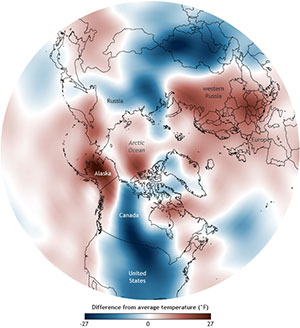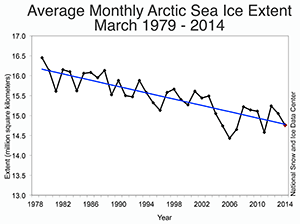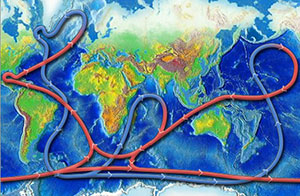Arctic sea shipping: Emissions matter more than you might think
Blog
Context matters: Making the case for black carbon mitigation in the Arctic

Difference from average air temperature across the Northern Hemisphere. Note the dark blue over Canada and the US with the red over the Arctic. (Credit: NOAA)
The snow accumulated by the last storm of the 2013–2014 winter has just melted in Washington DC, though it won’t be gone from New England and the Canadian Maritimes for a while yet. The polar vortex bringing frigid air this winter to parts of North America that hadn’t seen such weather in a long time has also spawned—or perhaps just coincides with—a rising interest in the connections between the warming Arctic and weather in the mid-latitudes (see here and here and here). With the Marine Environment Protection Committee of the International Maritime Organization meeting this week as well, it seems an opportune moment to talk briefly about sea ice, and specifically why the decline in sea ice extent should motivate us to focus harder on limiting ship emissions of black carbon.
The Arctic is warming at twice the global average. According to the National Snow and Ice Data Center, February 2014 had the fourth lowest Arctic sea ice extent on the satellite record (350,000 square miles below the 20 year average). On average, the Arctic is losing 17,800 square miles of winter sea ice each year.
While loss of Arctic sea ice cover is often noted as a symptom of climate change and a warming globe, this winter has focused attention on the role Arctic sea ice plays in influencing global weather patterns and driving ocean currents.

Monthly March ice extent for 1979 to 2014 shows a decline of 2.6% per decade relative to the 1981 to 2010 average. Credit: National Snow and Ice Data Center
The cyclical cooling and freezing of ocean water drives global ocean circulation. In the Atlantic, warm water moves north from the equator via the Gulf Stream. As it cools in Arctic latitudes it becomes very cold and very dense. A key component in this cold water formation: massive amounts of ice, which as it forms expels salt, increasing the salinity and density of the surrounding water, causing it to sink. The resulting “thermohaline circulation” is one of the key influences on global climate. As the Arctic water sinks, it pulls warmer Gulf water north in the Atlantic, bringing equatorial heat to the Northeast US, Newfoundland, and western Europe—without this current, the regional temperature would be much colder.
Most models predict a significant weakening [.pdf] of this cold-water formation in a warming Arctic. Slowing the thermohaline circulation would, for example, result in extended cooling in the North Atlantic because the warm equatorial waters would cease to flow far enough North. A recent Georgia Tech study linked declines in Arctic sea ice with intensification of winter weather in northeastern North America. The retreating ice [.pdf] is altering atmospheric circulation patterns, i.e. the Jet Stream, which could be leading to increased cold surges and snow over large parts of the northern continents. As the Arctic warms, less sea ice will form, slowing the circulation and changing the salinity of the Arctic—further weakening the northerly pull on equatorial water, changing climate in the northern latitudes.

Thermohaline circulation is a global overturning process with a time scale of up to 1000 years for some waters to travel from the Atlantic to the Pacific. (Credit: NOAA)
One major contributor to Arctic warming is the emission and deposition of black carbon (BC) on exposed snow and ice, which reduces the reflection of sunlight, increasing warming and subsequent melting. One contributor of BC to the Arctic is shipping, which by some predictions, could grow to 2000 vessels by 2030. Currently 33% of BC emissions in the Arctic come from shipping as far south as New York City and Beijing. Arctic BC emissions from international shipping are expected to grow fivefold through 2050, while emissions from land-based sources are expected to fall as controls are enacted, increasing the relative importance of shipping.
For the past several years the International Maritime Organization had two venues to address the issue of black carbon in the Arctic: through its sub-Committee on Ship Design and Construction (SDC) and the sub-committee on Pollution Prevention and Response (PPR). Although the SDC is designing international operating codes for vessels in the Arctic, discussions have focused on safety and security (rightly so given Arctic navigation challenges). But environmental standards, like limiting ship emissions to reduce black carbon in the Arctic, were not taken up. Instead PPR was asked to define a global standard for measurement and mitigation, which has languished, trapped by discussion of the definition of black carbon rather than methods to reduce its emission. This is doubly unfortunate because effective methods of mitigation exist and could be readily implemented in the Arctic where the need is most urgent. Fuel switching, scrubbers, new diesel particulate filters, slide valves, and alternative fuels are all possibilities, combinations of which can provide reductions in black carbon emissions of at least 60%.
Black carbon from shipping is not the only or even the largest contributor to the warming Arctic. But it is a significant source that we know how to mitigate immediately, and whose reduction would produce measureable benefit for the Arctic region, slowing overall warming and ice loss. It’s low-hanging fruit. The IMO should pick it.
